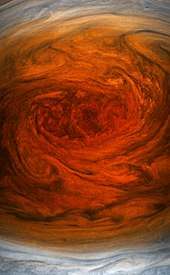Gravity science (''Juno'')

The Gravity Science experiment and instrument set aboard the Juno Jupiter orbiter is designed to monitor Jupiter's gravity.[1][2][3] Juno's gravity science experiment is intended to mapping Jupiter's gravitational field, which allows the interior of Jupiter to be better understood.[4] The gravity science experiment uses special hardware on Juno, and also on Earth.[5] GS uses the high-gain K-band and X-band communication system and communication systems on Earth of the Deep Space Network as well as special communication hardware on Juno called KaTS, or Ka-Band Translator System.[6][7] These components work together to detect minute changes in radio frequency, see Doppler shift, thus detecting the spacecraft's velocity over time.[8] The KaTS box was funded by the Italian Space Agency and overseen by a professor at University La Sapienza in Rome.[9] KaTS detects signals coming from the DSN on Earth, and then sends reply in a very precise way, that ultimately allows the velocity of Juno to hopefully be determined to within 0.001 millimeters per second.[10] The spacecraft receives a tone signal on the Ka-band but then replies using the X-band radio.[11]
As the spacecraft traverses the space near Jupiter, the planet, and even variations in the planets interior cause a variation in Juno velocity.[12] The gravity science experiment measures these velocity changes using a combination of hardware on Earth and the Spacecraft, which in turn allows the effect of gravity to be measured, and thus mass variations in Jupiter's interior.[13]
Communication signals:[14][15]
- Deep Space Network 25 sends tone signal 32.5 GHZ (Ka-Band)
- Juno KaTS sends tone signal at 35 GHZ (X-Band)
Juno launched in 2011 and arrived at Jupiter orbit in July 2016.[16]
The GS was planned out to be used on orbits 4, orbit 9, and orbits 10 through 32.[17] When GS operates it must point its antenna at Earth, and its is not operated simultaneously with the Microwave Radiometer instrument on Juno.[18]
See also
- Deep Space Network
- Gravity Recovery and Climate Experiment (GRACE, gravity science spacecraft for Earth)
- Jovian Infrared Auroral Mapper (ASI contributed instrument)
References
- ↑ "Instrument Overview – Juno". spaceflight101.com. Retrieved 2017-01-05.
- ↑ "Jupiter's Gravity Embraces NASA's Juno Spacecraft". Space.com. Retrieved 2017-01-05.
- ↑ "Juno's Instruments | Mission Juno". Mission Juno. Retrieved 2017-01-05.
- ↑ "Juno's Instruments | Mission Juno". Mission Juno. Retrieved 2017-01-05.
- ↑ "Instrument Overview – Juno". spaceflight101.com. Retrieved 2017-01-05.
- ↑ "Instrument Overview – Juno". spaceflight101.com. Retrieved 2017-01-05.
- ↑ "European Involvement in Juno | Europlanet Outreach". www.europlanet-eu.org. Retrieved 2017-01-05.
- ↑
- ↑ "European Involvement in Juno | Europlanet Outreach". www.europlanet-eu.org. Retrieved 2017-01-05.
- ↑ "European Involvement in Juno | Europlanet Outreach". www.europlanet-eu.org. Retrieved 2017-01-05.
- ↑ "Instrument Overview – Juno". spaceflight101.com. Retrieved 2017-01-05.
- ↑ "What will we learn from the Juno mission?". Science Focus. Retrieved 2017-01-05.
- ↑ "What will we learn from the Juno mission?". Science Focus. Retrieved 2017-01-05.
- ↑ "European Involvement in Juno | Europlanet Outreach". www.europlanet-eu.org. Retrieved 2017-01-05.
- ↑ "Instrument Overview – Juno". spaceflight101.com. Retrieved 2017-01-05.
- ↑ Greicius, Tony (2015-03-13). "Juno Spacecraft and Instruments". NASA. Retrieved 2017-01-04.
- ↑ "Gravity Science Orbits". Mission Juno. Retrieved 2017-02-07.
- ↑ "Gravity Science Orbits". Mission Juno. Retrieved 2017-02-07.

